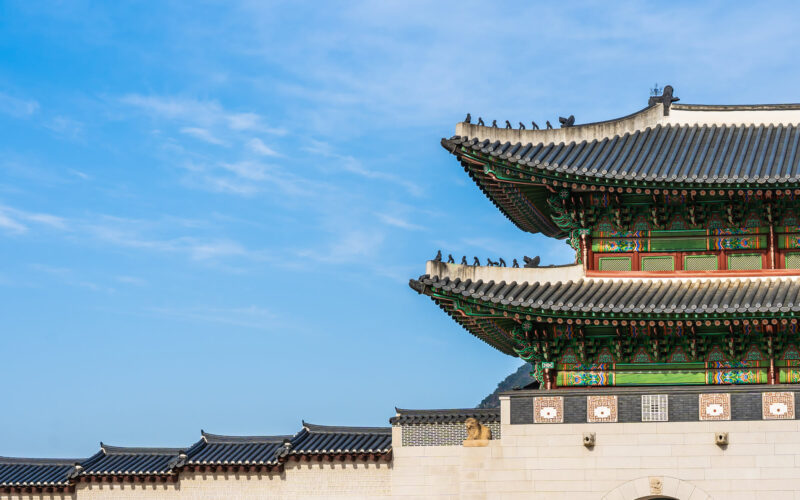Korean mythology is a group of myths written or told by historical or modern Koreans. There are two types, literary mythology and oral mythology. Literary mythology is mostly about the founding story of various historical kingdoms; these are often written under orders of kings to gain the righteousness of their dynasties. On the other hand, oral mythology tends to be much larger and more diverse than literary mythology. Oral mythology is mostly narratives sung or told by shamans, who are priests or priestesses of many deities, in rituals invoking the deities. These shamanic narratives are divided into five regional traditions, with each region having its own unique origins, as well as various versions of pan-Korean narratives.
Regional traditions are divided up into 5 different regions, Northern, West-Central, East Coast and Gyeongsang, Jeolla, and Jeju. Each regional tradition is different by the characteristics they possess. For example, Northern and West-Central regional traditions tend to focus on the shamanistic acts such as walking on blades of straw cutter barefoot or having a ritual for advents of deity, Gangshingut, while Jeolla or East Coast and Gyeongsang tends to focus on fortunetelling and rituals that does not present supernatural powers of the performer.
Jeju has the most diverse and well-preserved narratives because of its unique geographic features and culture; it is an island with harsh agricultural conditions which made people rely on religions more than any other religion. On the other hand, Jeju narratives were not targeted by the extreme religious movements done by Confucianist, Shintoists and Lutherans. Especially, while Protestantism of Korea had the most critical impacts on mythological narratives with the destruction of village shrines and illegalization of rituals as a backlash from persecution of Christianity by Joseon dynasty and Communists of Northern parts of Korea, Jeju island had less impacts by the anti-Christianity moods its people possess due to the Rebellion of 1901 or Jeju Uprising in 1948. However, the other regional narratives are not diverse or forgotten due to Japanese occupation, Korean War, and Saemaul Undong.
Also, original versions of Seoul and some central regional narratives are not found due to the fusion of Northern narratives by the Northern shamans as a large number of them were introduced into the region due to the Korean War. Other than shaman refugees, there was extreme oppression by the Confucianist movement throughout the Joseon dynasty by the monarchy not only in the West-Central region but other regions, too. Oppressed shamans altered some parts of the narratives with elements of Buddhism or Taoism in order to preserve them from such heavy oppressions. Due to that, Shamanic narratives often have proper nouns replaced with nouns from Buddhism or Taoism in all regions. For example, the creation of Korean mythology indicated that Maitreya has made the world while Buddists believe that Vairocana is the creator and not Maitreya. It has been indicated that Korean mythology has evolved over time by changing its proper nouns with other proper nouns to survive from harsh selection pressure created by oppression and other extreme religious movements.
While other regional narratives were oppressed throughout the Joseon dynasty and the modernization of Korea, Northern narratives had worse conditions under the harsh communist dictatorship of DPRK. The Workers’ Party of Joseon oppressed every religious activity by labeling them as the “opium of the people” throughout the 1960s to 1990s. However, Korean mythology appears to be a motif for deification of the Kim family, the dictators of DPRK. For example, some government officials claimed that Kim Jeong Un is able to control the weather with divine power he possesses, which is a motif from Dragons of Korean mythology. In shamanic narratives, Dragons, or Yong, were shown as messengers of deities or sometimes the deities themselves. These deifications of Kim family took motifs from Korean mythology.
Korean mythology has both characteristics of shamanism and animism. Shamanistic aspects of it are well represented by the Mudang, the shamans of Korean mythology. Korean shamans are priests of one or more deities and the roles of them are different corresponding to deity respectively. They are believed to be the only messenger of the deity and in Gut, Korean rituals invoking deity, they are sometimes thought to be the terrestrial body of the deity. On the other hand, animistic aspects of it are shown by the idea of Dongty, which is a condemnation by spiritual beings in certain places or objects, or worshiping of certain natural objects such as trees. Trees were often worshiped as spiritual beings and the largest and tallest trees in the villages often became a shrine for the patron deity of the village, Seonangshin.
Although Korean Mythology was widespread within the Korean Peninsula, due to various oppressions during the 16th century to 20th century, it does not bare the same glory as it did in the past. Also, pseudo-religious shamans and cults have made its status even lower. However, in recent years, there have been some recovery movements started by people who recognize the value of Korean Mythology and its cultural soft-power. Also, due to some major successes of movies and comics based on Korean mythology in Korean mainstream media, popularity of it has grown significantly, especially among the younger generation. Though there have been numerous instances of defamation and oppression of Korean mythology over time, it is an undeniable fact that it is an important aspect of Korean history and culture. It is also a valuable cultural heritage that is worth being preserved and inherited into the next generation of humanity.
References
encykorea.aks.ac.kr. (n.d.). 신화 – 한국민족문화대백과사전. [online] Available at: http://encykorea.aks.ac.kr/Contents/Item/E0033583 [Accessed 20 Oct. 2022].
문무병 (2018). 제주 큰굿 연구.
Yun, Y.-S. (2015). Research on Korea Mythology in Korea Subculture Contents. Cartoon and Animation Studies, 41, pp.553–578. doi:10.7230/koscas.2015.41.553.
Andronova, L.A. and Abrosimova, E.S. (2015). Mythologizing History in South Korea. Procedia – Social and Behavioral Sciences, 166, pp.601–604. doi:10.1016/j.sbspro.2014.12.580.
